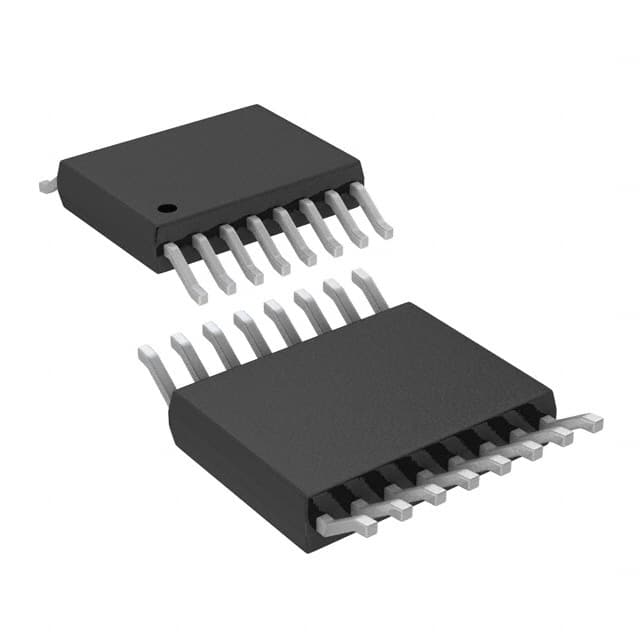LTC2367IMS-16#PBF
Product Overview
Category: Analog-to-Digital Converter (ADC)
Use: The LTC2367IMS-16#PBF is a high-performance 16-bit ADC designed for precision measurement applications. It provides accurate conversion of analog signals into digital format.
Characteristics: - High resolution: 16-bit - Low noise and distortion - Wide input voltage range - Fast conversion rate - Low power consumption
Package: The LTC2367IMS-16#PBF comes in a small MSOP-16 package, which allows for easy integration into various electronic systems.
Essence: The essence of the LTC2367IMS-16#PBF lies in its ability to convert analog signals with high precision and accuracy, making it suitable for demanding measurement applications.
Packaging/Quantity: The LTC2367IMS-16#PBF is typically sold in reels or tubes, containing a specified quantity of units per package.
Specifications
- Resolution: 16 bits
- Input Voltage Range: ±Vref
- Conversion Rate: Up to 250 kSPS
- Power Supply: 2.7V to 5.5V
- Operating Temperature Range: -40°C to 85°C
- Interface: SPI-compatible
Pin Configuration
The LTC2367IMS-16#PBF has a total of 16 pins arranged as follows:
```
| | | 1 2 3 4 5 6 7 8 | |_______________________________________|
```
Pin Description: 1. VIN+ : Positive Analog Input 2. VIN- : Negative Analog Input 3. VREF+ : Positive Reference Voltage Input 4. VREF- : Negative Reference Voltage Input 5. SCK : Serial Clock Input 6. SDI : Serial Data Input 7. SDO : Serial Data Output 8. CS : Chip Select Input
Functional Features
- High-resolution conversion: The LTC2367IMS-16#PBF offers 16-bit resolution, ensuring accurate representation of analog signals.
- Low noise and distortion: The ADC minimizes noise and distortion, resulting in high-quality digital output.
- Wide input voltage range: The device supports a wide input voltage range, allowing for versatile applications.
- Fast conversion rate: With a maximum conversion rate of 250 kSPS, the ADC can handle rapid signal changes.
- Low power consumption: The LTC2367IMS-16#PBF is designed to operate with low power consumption, making it suitable for battery-powered devices.
Advantages and Disadvantages
Advantages: - High resolution ensures precise measurement accuracy. - Low noise and distortion result in high-quality output. - Versatile input voltage range allows for various applications. - Fast conversion rate enables real-time data acquisition. - Low power consumption prolongs battery life.
Disadvantages: - Higher cost compared to lower-resolution ADCs. - Requires careful PCB layout and grounding for optimal performance.
Working Principles
The LTC2367IMS-16#PBF utilizes a successive approximation register (SAR) architecture to convert analog signals into digital format. It employs an internal reference voltage and a comparator to compare the input voltage with a series of binary-weighted voltages. The SAR iteratively determines the most significant bits (MSBs) first, followed by the least significant bits (LSBs), until the conversion is complete. The digital output is then available for further processing or storage.
Detailed Application Field Plans
The LTC2367IMS-16#PBF finds application in various fields that require high-precision analog-to-digital conversion. Some of the potential application areas include:
- Industrial Automation: The ADC can be used in industrial control systems for accurate measurement and monitoring of process variables.
- Test and Measurement Equipment: It is suitable for high-precision test and measurement instruments, such as data loggers and oscilloscopes.
- Medical Devices: The LTC2367IMS-16#PBF can be utilized in medical equipment that requires precise analog signal conversion, such as patient monitoring systems.
- Communications: It can be integrated into communication systems for signal processing and modulation/demodulation applications.
- Scientific Research: The ADC is valuable in scientific research where accurate data acquisition is crucial, such as in physics or environmental monitoring.
Detailed and Complete Alternative Models
- LTC2378-20: 20-bit resolution ADC with similar features and performance.
- ADS1262: 24-bit ADC with low noise and high accuracy.
- MAX11156: 16-bit ADC with integrated PGA and temperature sensor.
- MCP3421: 18-bit ADC with I2C interface and low power consumption.
- AD7091R
Senaraikan 10 soalan dan jawapan biasa yang berkaitan dengan aplikasi LTC2367IMS-16#PBF dalam penyelesaian teknikal
Sure! Here are 10 common questions and answers related to the application of LTC2367IMS-16#PBF in technical solutions:
Q: What is LTC2367IMS-16#PBF? A: LTC2367IMS-16#PBF is a high-performance, low-power, 16-bit analog-to-digital converter (ADC) manufactured by Linear Technology.
Q: What is the operating voltage range of LTC2367IMS-16#PBF? A: The operating voltage range of LTC2367IMS-16#PBF is from 2.5V to 5.5V.
Q: What is the maximum sampling rate of LTC2367IMS-16#PBF? A: The maximum sampling rate of LTC2367IMS-16#PBF is 250ksps (kilosamples per second).
Q: What is the resolution of LTC2367IMS-16#PBF? A: LTC2367IMS-16#PBF has a resolution of 16 bits, which means it can provide 2^16 (65,536) discrete digital output levels.
Q: What is the input voltage range of LTC2367IMS-16#PBF? A: The input voltage range of LTC2367IMS-16#PBF is from 0V to VREF, where VREF is the reference voltage provided externally.
Q: Does LTC2367IMS-16#PBF have an integrated reference voltage source? A: No, LTC2367IMS-16#PBF requires an external reference voltage source for operation.
Q: What is the power consumption of LTC2367IMS-16#PBF? A: The power consumption of LTC2367IMS-16#PBF is typically 5.6mW at a 250ksps sampling rate.
Q: What is the interface used to communicate with LTC2367IMS-16#PBF? A: LTC2367IMS-16#PBF uses a serial interface called SPI (Serial Peripheral Interface) for communication with microcontrollers or other devices.
Q: Can LTC2367IMS-16#PBF be used in battery-powered applications? A: Yes, LTC2367IMS-16#PBF has low power consumption and can be used in battery-powered applications.
Q: What are some typical applications of LTC2367IMS-16#PBF? A: LTC2367IMS-16#PBF is commonly used in precision measurement systems, data acquisition systems, industrial automation, medical equipment, and scientific instruments.
Please note that the answers provided here are general and may vary depending on specific application requirements. It is always recommended to refer to the datasheet and consult with technical experts for accurate information and guidance.


